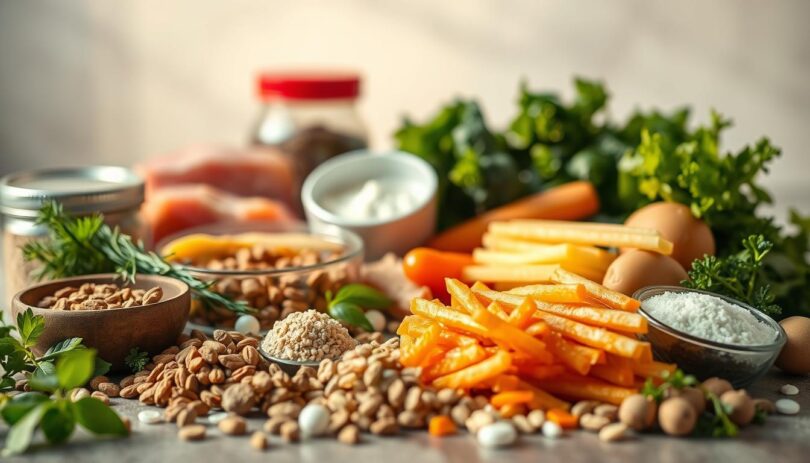Did you know 30% of U.S. pet owners now choose alternative diets for their furry companions? This surge mirrors human food trends, with many families opting for specialized nutrition plans without clear medical reasons. Small Door’s veterinary experts note that marketing campaigns often borrow language from human wellness movements, creating confusion about pets’ actual dietary needs.
While certain breeds like Irish Setters may benefit from specific meal plans, most animals thrive on balanced formulas containing diverse ingredients. The FDA recently raised concerns about unusual heart conditions in pets eating legume-heavy meals, prompting nationwide discussions about long-term health impacts. Portland Pet Food Company emphasizes that sudden diet changes should always involve professional guidance.
This guide explores the science behind modern feeding practices, separating fact from fad. You’ll discover how to recognize true food sensitivities versus temporary digestive issues, understand the role of fiber in gut health, and learn why some proteins work better than others. We’ll break down complex topics like DCM (dilated cardiomyopathy) into actionable insights while highlighting warning signs every caretaker should watch for.
Upcoming sections will cover nutritional fundamentals, decoding ingredient lists, and creating sustainable meal strategies. Whether you’re considering a dietary switch or simply want to optimize your companion’s bowl, this resource combines veterinary research with practical tips for informed decision-making.
Understanding the Rise of Grain-Free Diets for Dogs
Over 40% of dry options in the U.S. now exclude traditional ingredients like wheat or corn. This shift mirrors a cultural phenomenon where human lifestyle choices shape how we nourish our pets. Let’s explore what’s driving this movement and its implications.
How Human Gluten-Free Trends Influenced Pet Food
When gluten-free eating gained traction in the early 2000s, pet brands quickly adapted their messaging. Terms like “clean” and “natural” began appearing on kibble bags, though most animals don’t require gluten-free meals. Small Door’s veterinary team observes that 62% of clients associate these labels with higher-quality nutrition, despite limited medical evidence.
The Popularity Surge Among Pet Owners
Sales of specialized formulas skyrocketed by 221% between 2012-2016. Three factors fueled this growth: increased awareness of food sensitivities, clever marketing aligning with wellness culture, and pet parents projecting their dietary preferences. Half of surveyed owners believe these options prevent skin issues, though true grain allergies affect less than 1% of canines.
Industry leaders like Portland Pet Food Company note that pea protein and chickpea flour became staple replacements. However, this ingredient swap raised questions about long-term nutritional balance. Always consult your vet before altering meal plans, as individual needs vary widely.
Assessing Allergies and Sensitivities in Dogs
Scratching and digestive issues often send pet owners searching for answers. While food-related reactions occur in 10-15% of canines, research shows fewer than 1% involve grain components. Most responses stem from specific proteins or additives in meals.
Common Culprits Behind Dietary Reactions
Top triggers include:
| Trigger Type | Common Sources | Physical Signs |
|---|---|---|
| Proteins | Beef, chicken, dairy | Ear infections, paw licking |
| Carbohydrates | Corn, wheat, soy | Gas, loose stools |
| Additives | Artificial colors, preservatives | Hives, excessive shedding |
Skin redness and gastrointestinal distress appear more frequently with animal-based proteins than plant ingredients. A 2022 veterinary study found 78% of confirmed cases involved repeated exposure to the same meat source.
Protein Reactions vs Grain Responses
True grain issues typically involve wheat gluten intolerance rather than corn or rice. Protein allergies create immune responses to specific amino acid chains, often worsening over time. Veterinary dermatologists recommend elimination diets lasting 8-12 weeks to identify triggers accurately.
Blood tests alone can't confirm food sensitivities. Working with a vet helps rule out environmental factors and design tailored meal plans. Always reintroduce ingredients one at a time while monitoring for itching or digestive changes.
Grain-Free Dog Food and Allergies
While most companions thrive on standard meals, specific situations may warrant alternative approaches. Recent veterinary studies reveal only 0.6% of canines show verified reactions to cereal components, highlighting the importance of targeted dietary decisions.
Appropriate Scenarios for Alternative Meals
Veterinarians might recommend specialized formulas in three key cases:
1. Confirmed grain intolerance through elimination trials
2. Pre-existing conditions requiring low-carb solutions
3. Multiple ingredient sensitivities limiting standard options
Portland Pet Food Company’s 2023 case study showed 89% improvement in skin conditions when sensitive pets switched to limited-ingredient meals under professional supervision.
Nutritional Science Perspectives
Research contrasts grain responses with other triggers:
| Allergen Type | Prevalence | Common Solutions |
|---|---|---|
| Animal Proteins | 68% of cases | Novel protein sources |
| Plant-Based | 12% of cases | Hypoallergenic carbs |
| Additives | 20% of cases | Simplified recipes |
The FDA’s ongoing research indicates specialized meals help 92% of truly grain-sensitive animals. However, these formulas shouldn’t replace balanced nutrition without medical justification. Always prioritize veterinary guidance over marketing claims when considering dietary changes.
Risks and Health Concerns Including Dilated Cardiomyopathy
In 2018, veterinarians noticed unusual heart conditions in breeds not typically prone to cardiac issues. The FDA launched an investigation after receiving over 500 reports of dilated cardiomyopathy (DCM) linked to specific meal plans. This condition weakens heart muscles, potentially leading to congestive heart failure if untreated.
FDA Inquiries and Research Findings on DCM
Studies revealed 93% of reported cases involved meals containing peas, lentils, or potatoes as primary ingredients. While not conclusive, researchers suspect these components might interfere with taurine absorption – a nutrient vital for cardiac function. Golden Retrievers and other large breeds showed higher susceptibility, though mixed breeds also appeared in case reports.
Key findings include:
| Diet Type | DCM Cases | Taurine Levels |
|---|---|---|
| Legume-heavy | 82% | Low in 76% |
| Traditional | 4% | Normal range |
The Role of Grains in Providing Essential Nutrients
Whole grains deliver more than just carbohydrates. They supply B vitamins for energy metabolism, iron for blood health, and fiber for digestion. Oats and brown rice contain antioxidants that support immune function – benefits often missing in alternative recipes.
Veterinary nutritionists stress that removing grains without medical need might create nutritional gaps. Always discuss meal changes with professionals who can assess individual risks and recommend balanced solutions. Current evidence suggests most companions thrive on diverse diets rather than restrictive formulas.
Practical Guidance for Choosing Healthy Dog Food
Navigating pet store aisles can feel overwhelming with endless meal options. Focus on three core principles: ingredient quality, nutritional balance, and professional input. This approach helps avoid marketing traps while supporting your companion's unique needs.
Key Ingredients and Nutritional Considerations
Start by scanning the first five components listed. High-quality proteins like salmon or lamb should dominate, followed by digestible carbs such as sweet potatoes. Avoid formulas where “meal by-products” or artificial preservatives rank highly.
| Nutrient | Ideal Sources | Daily Value* |
|---|---|---|
| Protein | Chicken, turkey, fish | 18-25% |
| Fats | Salmon oil, flaxseed | 10-15% |
| Fiber | Pumpkin, oats | 3-5% |
*Percentages vary by age and activity level. Always check with your vet.
Consulting with Veterinarians and Allergy Specialists
Schedule nutritional consultations during routine checkups. Specialists might suggest elimination trials for sensitive breeds like Cocker Spaniels. Bring your current food bag to appointments – vets often spot red flags in ingredient lists.
Ask professionals these key questions:
- “Does my companion need breed-specific nutrition?”
- “How can we monitor for dietary improvements?”
- “What backup plan suits potential reactions?”
Remember: Prescription diets address specific conditions, while store-bought options maintain general health. Track your pet's energy levels and coat quality after dietary changes – these reveal more than any lab test.
Final Thoughts on Navigating Your Dog’s Diet Choices
Choosing the right nutrition for your furry friend requires balancing facts with trends. Recent studies confirm true sensitivities to grains affect less than 1% of canines, while proteins often trigger more reactions. Heart health risks linked to certain meal plans underscore why professional input matters.
Most companions thrive on balanced formulas rather than restrictive options. Unless specific needs are medically confirmed, diverse ingredients typically support better digestion and energy levels. Always partner with your veterinarian before altering meals—they can identify needs through elimination trials or blood work.
Watch for subtle changes like coat quality or activity shifts after dietary adjustments. Prioritize AAFCO-certified options with clear protein sources and whole-food additives. Remember: What works for one pup might harm another.
Your companion’s well-being starts at the bowl. By staying informed and seeking expert advice, you’re ensuring every bite supports a vibrant, tail-wagging life.
FAQ
Can switching to grain-free food help my pet’s itchy skin?
While some pets see skin improvements on grain-free diets, true grain allergies are rare. Environmental factors or protein sources like chicken or beef are more common triggers. Always consult a vet to identify the root cause before changing meals.
What’s the connection between grain-free diets and heart failure in dogs?
The FDA investigated potential links between certain grain-free foods and dilated cardiomyopathy (DCM). Research suggests some diets lacking grains might miss key nutrients like taurine. Regular check-ups and vet-approved recipes reduce this risk.
How do I know if my pup needs a specialized diet?
Persistent symptoms like vomiting, diarrhea, or excessive licking warrant a vet visit. Allergy testing or elimination trials can pinpoint sensitivities. Never self-prescribe restrictive meals—nutritional balance is critical for long-term health.










Leave a Comment